Anthony Bourdain visits Osaka, Japan where he learns all about kuidaore, which means to bankrupt yourself with extravangances in food and drink, or simply "eat until you drop". He visits an underground bar devoted to the hardcore fans of the local baseball team, the Hanshin Tigers, and attends one of their baseball game.
Introduction:
Osaka is a city in the Kansai region of Japan's main island of Honshū, and the capital city of Osaka Prefecture. Located at the mouth of the Yodo River on Osaka Bay, Osaka is the third largest city by population after Tokyo and Yokohama.
Historically the commercial capital of Japan, Osaka functions as one of the command centers for the Japanese economy. Its nighttime population is 2.6 million, the third in the country, but in daytime the population surges to 3.7 million, second only after Tokyo, highlighting its status as an economic center. There were 99,775 registered foreigners, the two largest groups being Korean (71,015) and Chinese (11,848). The commonly spoken dialect of this area is Osaka-ben.
Since ancient times, Osaka has been a gathering place. Located at the confluence of a vast web of busy river and sea routes, it naturally grew into a flourishing economic center and became the gateway to Japan for travelers and traders from all over Asia. It was here that Japan first met the world. Naniwazu Port, the predecessor to the modern port of Osaka, became a gateway into ancient Japan for visitors from Korea, China and the Asian continent who brought with them knowledge and artifacts of advanced culture, and new technologies in ceramics, forging, construction, and engineering.
Over the course of Japan's Edo period (1603–1867), Osaka grew into one of Japan's major cities and returned to its ancient role as a lively and important port. Osaka used to be referred to as the "nation's kitchen" because it was the centre of trading for rice, creating the first modern future exchange market in the world. Osaka was, for a long time, Japan's most important economic center, with a large percentage of the population belonging to the merchant class. Merchants were ranked the lowest class due to the fact that they do not produce anything, only profit from others' creations. Ironically, the merchant class were often the wealthiest group and held influence above and beyond their supposed social standing.
Osaka residents were stereotyped in Edo literature from at least the 18th century. In 1809 the derogatory term "Kamigata zeeroku" was used by Edo (present-day Tokyo) residents to characterize inhabitants of the Osaka region in terms of calculation, shrewdness, lack of civic spirit, and the vulgarity of Osaka dialect. Edo writers aspired to samurai culture, and saw themselves as poor but generous, chaste, and public spirited. Edo writers by contrast saw "zeeroku" as obsequious apprentices, stingy, greedy, gluttonous, and lewd. To some degree, Osaka residents are stigmatized by Tokyo observers in much the same way down to the present, especially in terms of gluttony. As a famous saying has it, "Osaka wa kuidaore" (Osaka people eat 'til they drop).
The modern municipality was established in 1889. Osaka was the industrial center most clearly defined in the development of capitalism in Japan. The rapid industrialization attracted many Korean immigrants, who set up a life apart for themselves. The political system was pluralistic, with a strong emphasis on promoting industrialization and modernization. Literacy was high and the educational system expanded rapidly, producing a middle class with a taste for literature and a willingness to support the arts.
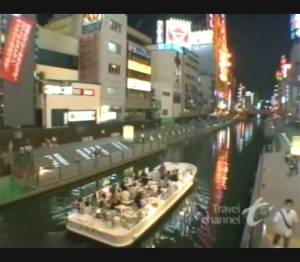 The devastation during World War II was enormous, as fleets of American B-29 bombers blasted away on a regular basis in the last year of the war. Many people fled and most of the industrial districts were severely damaged. However the city quickly rebuilt its infrastructure after 1945 and regained its status as a major industrial and cultural center.
The devastation during World War II was enormous, as fleets of American B-29 bombers blasted away on a regular basis in the last year of the war. Many people fled and most of the industrial districts were severely damaged. However the city quickly rebuilt its infrastructure after 1945 and regained its status as a major industrial and cultural center.
Today, commerce, services, and manufacturing have been the three major industries, accounting for 30%, 26%, and 11% of the total, respectively. Osaka, along with Paris and London, has one of the most productive hinterlands in the world. According to a U.S. study, Osaka is the second most expensive city for expatriate employees in the world and in Japan behind Tokyo.
Osaka is the birthplace of Bunraku, one of the most surprising and exciting puppet theaters in the world. The large puppets are usually manipulated by three puppeteers, and such close control gives them the power to display an extraordinary gracefulness and human-like expressiveness. UNESCO declared Bunraku an Intangible Cultural Heritage.
"Kuidaore," which literally means "eat until you drop" or "stuff yourself until you can't eat anymore," describes Osaka's food loving culture. You can readily find the finest French, Italian, Chinese, Korean, Indian, and Thai food at restaurants throughout Osaka, or you can try more exotic cuisines, from Indonesia, Turkey, Nepal, Peru, Vietnam etc. Of course, Osaka also offers every variation of delicious authentic Japanese cuisine, as well as its own distinctive tastes of Osaka.
Episode Recap:
Anthony Boudain reveals how the Osaka's history and geographic location has made it the culinary center of the country.
Japanese take baseball very seriously, and none more than the Osakans. Hanshin Tigers is Osaka's professional baseball team. Reinforcing Osaka's "second-city" status is its baseball rivalry with the Tokyo Giants. Sixty percent of the country are Giants fans. The Tigers-Giants rivalry is considered the national Japanese rivalry, on par with the New York Yankees vs. the Boston Red Sox in Major League Baseball. Hanshin fans are reputed around Japan to be the most fervently devoted and blindly loyal fans in the world. They often outnumber the home team fans at Tigers "away" games.
Baseball-themed Bar and Restaurant: Anthony decides to explore the fanatic baseball culture of the Japanese by paying a visit to one of the many baseball-themed restaurants dedicated to the hardcore fans of the local baseball team, the Hanshin Tigers. The sushi chefs are not only also the scorekeeper, but often lead the ouendan in their cheers. They not only serve sushi and good Japanese food, but all beers are only 40 cents (US) when the Tigers win.
The Tigers ouendan, or cheer squads, lead the crowds in organized chants and cheers. They're notorious for making a lot of noise with taiko drums, blowing horns and other items, waving flags and banners, and yelling through plastic megaphones. They go to every single home game and come to places like this one for every away game.
They also get together between games and during off-season to practice cheering and chanting. Every single player on the roster has a themed chant which is sung the entire time he's up at bat. What's more, whether at the stadium or watching the game on TV, when the team's up, no one talks, gets food, or goes to the bathroom; you wait until the other team is batting. In addition to cheering for their own teams, ouendans have been known to lead fans in cheers which tease and taunt the other team and its fans.
Dōtonbori: Anthony meets up with Ken and Soro, a young Manzai duo, for an old-fashioned Osakan all-day-and-night kuidaore crawl through historic Dōtonbori. A former pleasure district, Dōtonbori is famous for its historic theaters (all gone now), its shops and restaurants, and its many neon and mechanized signs. Dōtonbori is one of the principal tourist destinations in Osaka.
Manzai is a form of comedy that is equal parts stand up and slapstick styles. Much like American Vaudeville in its mix of verbal humor and physical comedy, Manzai duos went from theaters to radio to television as the times changed. The roles of straight man and buffoon are similar to Dean Martin and Jerry Lewis or Abbott and Costello.
Pizza Ball House: Anthony meets up with Ken and Soro, a young Manzai duo, for an old-fashioned Osaka kuidaore crawl. They begin at Pizza Ball House where you can make your own. Takoyaki is a popular ball-shaped Japanese dumpling, or more like a savory pancake, made of batter and cooked in a special takoyaki pan. It is typically filled with diced or whole baby octopus, tempura scraps (tenkasu), pickled ginger, and green onion.
Jiyūken Restaurant: Next Anthony and the Manzi duo stop at Jiyūken Restaurant, the once favorite eating and writing spot of Sakunosuke Oda. Oda was particularly fond of the Japanese curry rice dish served at Jiyūken, for which it is now famous. He even wrote about it in several of his books. Anthony and his Manzai side-kicks sit at Oda's favorite table and order his favorite dish.
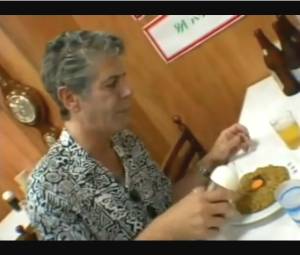
Oda was a member of the Buraiha or Decadent School, a group of dissolute writers who expressed the aimlessness and identity crisis of post-World War II Japan. Their work was based on criticism of the complete body of pre-war Japanese literature as well as American social values that were introduced into the Japanese society with the occupation. Buraiha writers are sometimes referred to as the "decadents" in the west because of the decadent lifestyle they lead, spending time in bars, using narcotics, and having frequent sexual relationships. During Oda's lifetime, several of his works were banned, but he was also championed by others for his ability to write candidly about the human condition with the sympathy and wit for which his native Osaka is famous.
Daruma Restaurant: Anthony and the Manzai duo continue their kuidaore crawl with a visit to Daruma Restaurant. They order the kushikatsu, a Japanese-style of deep-fried kebab. Kushikatsu can be made with chicken, pork, seafood, and seasonal vegetables. These are skewered on bamboo kushi; dipped in egg, flour, and panko; and deep-fried in vegetable oil. They may be served straight or with tonkatsu sauce. Anthony tries the beef, shrimp and tomato kushikatsu, and decides that Osakan food is good "beer food".
Kani Doraku Crab Restaurant: Anthony and his Manzai side-kicks stop to get some grilled crab legs at the restaurant's street kiosk. Then once again, they're off for yet more food.
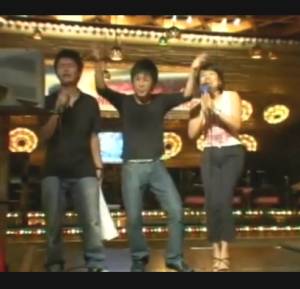 Dōtonbori Kuidaore crawl: From sushi to NY cheesecake, and from fried noodles to icy octopus balls, Anthony begins to suspect that the Ken and Soro can eat him under the table. After the main event—Osaka-style okonomiyaki—Anthony has to call it quits. Okonomiyaki is served throughout most of Japan. It is sometimes compared to an omelette or a pancake and may be referred to as "a Japanese pancake" or even "Osaka soul food". The batter is made of flour, grated yam, water or dashi, eggs and shredded cabbage, and usually contains other ingredients such as green onion, meat (generally pork or bacon), octopus, squid, shrimp, vegetables, kimchi, mochi or cheese.
Dōtonbori Kuidaore crawl: From sushi to NY cheesecake, and from fried noodles to icy octopus balls, Anthony begins to suspect that the Ken and Soro can eat him under the table. After the main event—Osaka-style okonomiyaki—Anthony has to call it quits. Okonomiyaki is served throughout most of Japan. It is sometimes compared to an omelette or a pancake and may be referred to as "a Japanese pancake" or even "Osaka soul food". The batter is made of flour, grated yam, water or dashi, eggs and shredded cabbage, and usually contains other ingredients such as green onion, meat (generally pork or bacon), octopus, squid, shrimp, vegetables, kimchi, mochi or cheese.
Karaoke Bar: After profusely and adamantly proclaiming the it's even written into his contract that he doesn't do karoke, Anthony somehow finds himself in a karoke bar watching the Manzai duo and his olf friend Michigo performing on stage.
Kiso Valley: Anthony accompanies his friend Michigo to the Kiso Valley. Kiso Valley was once a section of the old Nakasendo Highway, one of Japan's historic transport arteries joining Kyoto with Edo (present-day Tokyo). Roughly following the Kiso River, the once-important post towns now form a well-preserved living museum of the Edo Period, with most modern facilities being hidden from sight.
Narai: Anthony hops a train to the town of Narai, once the most prosperous of the post towns, it was called "Narai of a Thousand Houses." The postwar reconstruction and building boom spared a handful of towns like Narai, and they've become popular touchstones to the past, albeit there's admittedly a bit of theme-park feel to these towns. What used to be way-station inns are now destination inns.
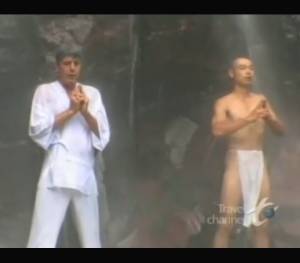 Mount Ontake: Anthony visits Mount Ontake, the second highest volcano in Japan. Mount Ontake is considered to be spiritual, and at Michigo's suggestion, Anthony goes there to perform a ontakekyo (or mitakekyo), a Shinto ritual done by sitting under a waterfall and becoming one with the icy cold mountain water with the intent to overcome one's fear and purify one's spirit.
Mount Ontake: Anthony visits Mount Ontake, the second highest volcano in Japan. Mount Ontake is considered to be spiritual, and at Michigo's suggestion, Anthony goes there to perform a ontakekyo (or mitakekyo), a Shinto ritual done by sitting under a waterfall and becoming one with the icy cold mountain water with the intent to overcome one's fear and purify one's spirit.
Kiso Valley Forest: Michigo and Anthony tour a section of the Kiso Valley Forest with their guide, Mr. Nakamura, whose family has lived in the Kiso Valley for the past five generations working as purveyors of the hinoki cypress trees that grow there to be used explicitly for rebuilding the Ise Shrine. The Ise Shrine is a Shinto shrine dedicated to goddess Amaterasu-ōmikami, a sun goddess and one of the principal Shinto deities (kami). She is said to be directly linked in lineage to the Imperial Household of Japan and the Emperor, who are considered descendants of the kami themselves.
Hinoki cypress is a slow-growing tree which is grown for its very high quality timber in Japan, where it is used as a material for building palaces, temples, shrines, traditional noh theatres, baths, table tennis blades and masu. The wood is lemon-scented, light pinkish-brown, with a rich, straight grain, and is highly rot-resistant. While all trees are seen by the Japanese as having a life-force, the hinoki grown in the Kiso Forest are called Go-Shin-boku ("Tree where god stayed", or simply "God trees").
Nakamura Home: At the invitation of Mr. Nakamura, Anthony and Michigo join the Nakamura family for a festive meal and to celebrate Obon.
Obon is a Japanese Buddhist custom to honor the departed (deceased) spirits of one's ancestors. This Buddhist custom has evolved into a family reunion holiday during which people return to ancestral family places and visit and clean their ancestors' graves, and when the spirits of ancestors are supposed to revisit the household altars. It has been celebrated in Japan for more than 500 years and traditionally includes a dance, known as Bon-Odori. The festival of Obon lasts for three days.
Many Obon celebrations include a huge carnival with rides, games, and summer festival food like watermelon. The festival ends with Toro Nagashi, or the floating of lanterns. Paper lanterns are illuminated and then floated down rivers symbolically signaling the ancestral spirits' return to the world of the dead. This ceremony usually culminates in a fireworks display.
A Horumonyaki Restaurant: Anthony meets up with his new guides, Hideki and his brother Teruki, a local club D.J., for some horumonyaki. Horumonyaki is a kind of Japanese cuisine, of Korean origin, made from beef or pork offal. Horumonyaki has the reputation of being "stamina building" food. Anthony orders it all: tripe, liver, tongue, kidney, and heart.
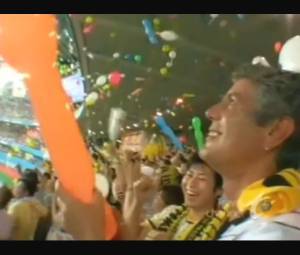 Hanshin Koshien Stadium: Anthony sits with the ouendan he met in the sports bar his first night in town. Anthony really gets into the team spirit: from the Tigers T-shirt and towel, to the ballpark fare of beer, edamame and hot dogs, to the jetto fuusen—the famous Hanshin Tigers screaming balloons, released during the seventh-inning stretch.
Hanshin Koshien Stadium: Anthony sits with the ouendan he met in the sports bar his first night in town. Anthony really gets into the team spirit: from the Tigers T-shirt and towel, to the ballpark fare of beer, edamame and hot dogs, to the jetto fuusen—the famous Hanshin Tigers screaming balloons, released during the seventh-inning stretch.
Hanshin Koshien Stadium is the oldest ballpark in Japan; built in 1924, the stadium was once visited by American baseball legend Babe Ruth on a tour of Major League stars in 1934. The home field of the Tigers, Hanshin Koshien Stadium, is one of three major natural grass baseball stadiums in Japan.
Kyoshi Sushi Bar: Anthony visits the small intimate Kyoshi Sushi Bar to indulge himself in one of his most favorite foods: sushi. The sushi is so good, the restaurant doesn't provide additional sauces or condiments for the dishes. Anthony blissfully dines on otoro tuna (pink fatty tuna), anago (salt-water eel), unagi (fresh-water eel), and hamo eel sushi, and the very rare and expensive ($50 a pop!) abalone.
Anthony concludes that from his trip to Osaka, he's learned about that noblest of concepts, kuidaore—that it's okay to blow your money on meals because, at the end of the day, it's not just the food; it's all the things and all the people and all the experiences that come with it.
Episodes:
 |
ARGENTINA: From the Tango to paragliding to cattle rustling to trekking along icy glaciers, Anthony experiences it all. |
 |
AUSTRALIA: Melbourne has been described as San Francisco without the fog. Anthony is off to discover what makes it so special. |
 |
BERLIN: Anthony finds himself in Berlin, a city that is for him both good and evil, Eastern and Western, repulsive and appealing. |
 |
BRAZIL: Some say São Paulo feels like LA threw up on NYC. But Anthony's back for the great food and its welcoming people. |
 |
CALCUTTA & BOMBAY: Anthony revisits his love for India's vibrant culture, cuisine & communities with a trip to Kolkata & Mumbai. |
 |
COLOMBIA: A bright and beautiful country that has gone from drug capital to food capital. Anthony explores its unique cuisine. |
 |
EGYPT: Anthony skips the long lines and tour buses, and visits with Egyptian locals to get a taste for what it means to be Egyptian. |
 |
GHANA: Anthony heads to Ghana, West Africa, a land of old forts and slave castles, and a culture filled with great food and music. |
 |
GREEK ISLES: Anthony is on a culinary odyssey to discover if Greece really does have the world's healthiest diet. |
 |
HONG KONG: A wonder-land of colors, lights and speed, a perfect marriage of modern and traditional, and home to great Asian cuisine. |
 |
IRELAND: Ireland's steeped in history and traditions, both oral & written. Anthony dispels the myths that it has the worst food on the planet. |
 |
JAMAICA: Jamaica is a vibrant, colorful land full of resorts and reggae music. Anthony is there to uncover the lesser-known Jamaica. |
 |
KOREA: Anthony gives in to his employee's pressure to visit Korea and, next thing you know, they're in Seoul and the adventure begins. |
 |
MEXICO: Carlos, a head chef in NYC and good friend, gives Anthony a culinary tour of his hometown Puebla and nearby Mexico City. |
 |
PARIS: In this very first episode of the series, Anthony heads to the "City of Light" to show, at least the Americans, why the French don't suck. |
 |
PERU: Anthony is on a mission to obtain personal enlightenment in a land of ancient culture, rich cuisine, and vibrant people. |
 |
QUEBEC (Canada): Anthony is off to Québec to indulge in one of his most hedonistic pleasures–foie gras (fatty duck liver). |
 |
RAJASTHAN (India): From gorgeous sights to enticing smells, Anthony explores the magical and delicious offerings of Rajasthan. |
 |
ROME: Anthony adopts the mindset of the Roman people–living a simple life and eating fresh, seasonal ingredients. |
 |
RUSSIA: Anthony explores Russia, where the food is hearty. Along the way he meets a former Cold War spy and Miss Russia. |
 |
SHANGHAI (China): Anthony is back in China. From Shanghai to Tibet, he searches for the mythical Shangri-La. |
 |
SICILY: Anthony starts his gastronomic tour through Sicily in style by sharing a spleen sandwich with Sicily's president. |
 |
SINGAPORE: Singapore is serious about food and offers up a cuisine like no other. Anthony dives in head-first. |
 |
SPAIN: According to Anthony, outside of Asia, Spain is the single greatest place for culinary achievement in the world. |
 |
TOKYO: Anthony is off to Tokyo in search of the relationship between a perfect piece of sushi and a perfect knife blade. |
 |
TUSCANY: Anthony travels to the beautiful Tuscan countryside to visit with friends and enjoy some homemade pasta that's out of this world. |
 |
URUGUAY: Anthony and his brother are on a mission to connect with their roots in Uruguay after learning that Bourdains once settled here. |
 |
VANCOUVER (Canada): Anthony visits Vancouver, home to a thriving film industry, gorgeous scenery, and an evolving food scene. |
Contact Us | Shop | Sitemap | Join Our Team | Investors | Advertise | Web Design Services
Community | Foodies' Choice | Meetup Groups | Chat | Blogs | Forums | Submit Your Site | Resources
